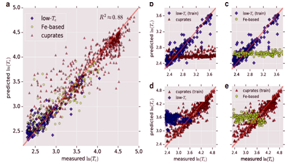 Machine learning modeling of superconducting critical temperature(超导转变温度的机器学习模型)
Machine learning modeling of superconducting critical temperature(超导转变温度的机器学习模型)
Valentin Stanev, Corey Oses, A. Gilad Kusne, Efrain Rodriguez, Johnpierre Paglione, Stefano Curtarolo & Ichiro Takeuchi
npj Computational Materials 4:29 (2018)
doi:s41524-018-0085-8
Published online:28 june 2018
Abstract| Full Text | PDF OPEN
摘要:超导自一个多世纪以前被发现以来就一直是研究的焦点。目前,该现象的部分特征仍然很难理解,其中超导特性与材料的化学组分/结构性质之间的关系是一个主要的问题。为解决这一问题,本研究开发了几种机器学习方案,用于模拟SuperCon数据库中12,000多种已知超导体的超导转变温度(Tc)。首先根据材料的转变温度Tc是否高于10K这一标准将其分为两类,并训练一个分类模型来预测该标记。该模型采用基于化学组分的粗粒度特征,显示出强大的预测能力,其样本外准确度可达到92%。为预测铜基、铁基和低Tc化合物等材料转变温度分别建立回归模型。这些模型同样显示了较好的预测能力,同时通过学习获得的预测因子为探索不同材料体系的超导机理提供了线索。为提升这些模型的准确度和可解释性,采用AFLOW在线存储库中的材料数据在模型中加入了新的特征。最后,将分类和回归模型结合成一个集成管道,应用于无机晶体结构数据库中搜索潜在的新型超导体。我们发现了30多个非铜基、铁基氧化物为潜在的超导材料。
Abstract:Superconductivity has been the focus of enormous research effort since its discovery more than a century ago. Yet, some features of this unique phenomenon remain poorly understood; prime among these is the connection between superconductivity and chemical/structural properties of materials. To bridge the gap, several machine learning schemes are developed herein to model the critical temperatures (Tc) of the 12,000+ known superconductors available via the SuperCon database.Materials are first divided into two classes based on their Tcvalues, above and below 10?K, and a classification model predicting this label is trained.The model uses coarse-grained features based only on the chemical compositions.It shows strong predictive power, with out-of-sample accuracy of about 92%.Separate regression models are developed to predict the values of Tc for cuprate, iron-based, and low-Tc compounds.These models also demonstrate good performance, with learned predictors offering potential insights into the mechanisms behind superconductivity in different families of materials.To improve the accuracy and interpretability of these models, new features are incorporated using materials data from the AFLOW Online Repositories.Finally, the classification and regression models are combined into a single-integrated pipeline and employed to search the entire Inorganic Crystallographic Structure Database (ICSD) for potential new superconductors. We identify >30 non-cuprate and non-iron-based oxides as candidate materials.
Editorial Summary
Superconductivity: machine learning predicts superconducting transition temperature (超导:机器学习预测超导转变温度)
该研究开发了机器学习方案准确地模拟了12,000多种化合物的超导转变温度。一个由马里兰大学帕克校区Valentin Stanev教授领导、杜克大学及美国国家标准局的研究人员参与的研究团队,开发了几种机器学习方案,对超过12,000种已知超导体和候选材料的超导转变温度(Tc)进行建模。他们首先基于化学成分训练了一个分类模型,以Tc是高于还是低于10 K为标准对已知超导体进行分类。然后,他们开发了回归模型来预测各种化合物的Tc值。这些模型的准确性通过借用AFLOW在线存储库中的材料数据得到了进一步提升。他们将分类和回归模型组合成一个集成管道,搜索了整个无机晶体结构数据库并预测出30多种新的潜在超导体。
Machine learning schemes are developed to model the superconducting transition temperature of over 12,000 compounds with good accuracy. A team led by Valentin Stanev from the University of Maryland at College Park and including researchers from Duke University and NIST develops several machine learning schemes to model the critical temperature (Tc) of over 12,000 known superconductors and candidate materials.They first train a classification model based only on the chemical compositions to categorize the known superconductors according to whether their Tc is above or below 10?K. Thenthey develop regression models to predict the values of Tc for various compounds.The accuracy of these models is further improved by including data from the AFLOW Online Repositories.They combine the classification and regression models into a single-integrated pipeline to search the entire Inorganic Crystallographic Structure Database and predict more than 30 new candidate superconductors.


 沪公网安备 31010502006565号
沪公网安备 31010502006565号